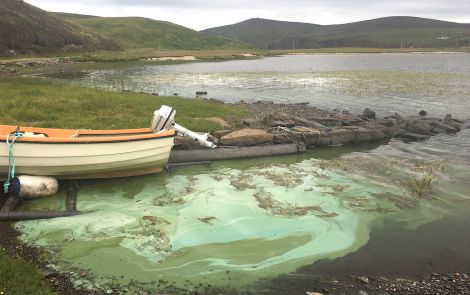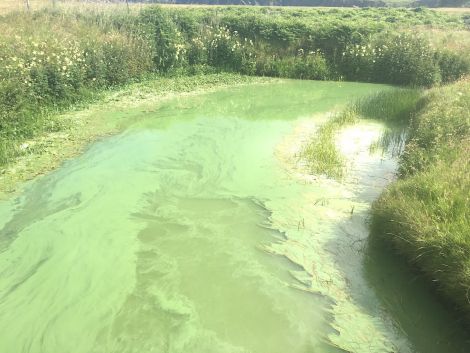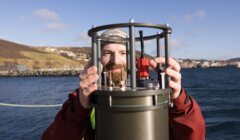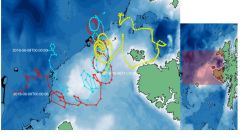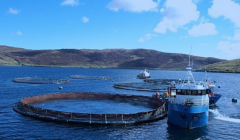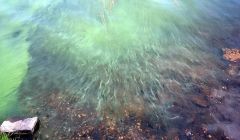Environment / What’s behind the regular algae bloom outbreaks
As the number of local lochs affected by toxic algae bloom rises to six, the regularly occurring phenomenon is not entirely natural, writes Alex Purbrick.
OUTBREAKS of algae blooms have occurred in several lochs throughout the isles over recent years during the summer months when temperatures rise and algal growth flourishes.
Harmful algal blooms are becoming more prevalent and toxic throughout Scotland’s rivers and lochs as drier, warmer summers encourage its growth.
However toxic algal blooms are not an entirely natural incident as they occur when there is an excess of nutrients in the water, predominantly nitrogen and phosphate waste which combined with heat and sunlight form a toxic soup which gives the appearance of a layer of blue green paint laying on the top of the water.
Algae and aquatic plants rely on nitrogen and phosphate for their growth naturally. Excessive amounts of nitrogen and phosphorus in the water encourage a toxic algal outbreak.
An overabundance of nitrogen and phosphate in water can occur due to varying factors such as land development, agricultural fertiliser run off, animal manure run off, aquaculture waste and chemical waste dispersal.
If there is only a small burn draining a loch then these waste nutrients have a low chance of diffusion which means the toxic algae has no easy way of being flushed out.
Toxic algal blooms can be very erratic appearing one day in full force and disappearing the next. However, there are some lochs in Shetland that are more predisposed to toxic algae than others.
One of these is the Loch of Cliff in the northwest of Unst which has witnessed many seasonal toxic algal outbreaks over the years and is currently experiencing a fresh outbreak of algal growth.
Sitting on the edge of Hermaness nature reserve, the Loch of Cliff is a rich aquatic ecosystem visited by many species of seabirds most notably great skua and red throated divers as well as waders and waterfowl. Its freshwater is famous for its abundant trout attracting anglers from Shetland and elsewhere.
Become a member of Shetland News
Water from the loch flows out through a small burn onto the Burrafirth beach which is frequented by locals and tourists.
The Loch of Cliff is also home to the Quoys hatchery and salmon cages, owned by Cooke Aquaculture Ltd.
The salmon industry has been under scrutiny in recent years as the increase in salmon farming generates pressure on natural ecosystems. A Review of the Environmental Impacts of Salmon Farming in Scotland was published by the Scottish Parliament in 2018 examining the effects a salmon farms ‘footprint’ may have on the seabed of lochs and voes.
It highlights the fact that salmon farming can create a large amount of nitrogen and phosphorous in the water, due to salmon faeces and uneaten nutrient rich salmon feed.
An excess of these nutrients creates eutrophication and if there is a low dispersal of water within a freshwater loch the capacity of the local ecosystem to disperse and recycle the waste will be overloaded and can result in toxic algal bloom.
Marine eutrophication can cause large fish losses for salmon farmers, an example being Loch Fyne in Argyll and Bute where thousands of farmed salmon died in April 2019 due to an algal bloom outbreak.
It also increases emissions of greenhouse gases, methane and nitrous oxide, all contributors to global climate change. Scientists are aware that restricting toxic algal growth in global waters is important to preserve fragile water supplies and to avoid acceleration of climate change.
Cooke Aquaculture said it was aware of the current algae bloom alerts but insisted it was a natural occurrence.
“Algal blooms occur naturally during the summer months and affects lochs in Shetland and across mainland Scotland on an annual basis,” a company spokesperson said.
“We understand there are currently algal blooms on five lochs across Shetland.
We are aware of the presence of blue-green algae at Loch of Cliff and we will monitor the situation closely over the coming weeks.”
Due to many underlying factors contributing to toxic bloom outbreaks it is difficult to specify exact causes or predict their duration as change of wind direction and heavy rain fall can alter an algal bloom overnight.
However, the dangers of exposure can be extremely harmful to humans causing adverse medical effects including skin rashes, eye irritations, vomiting, diarrhoea, fever and pains in muscles and joints.
SEPA said it was aware of blue-green algae growth in the Loch of Cliff. Shetland Islands Council’s environmental health team has been informed.
David Robertson of the environmental health department said: “Signs will soon be erected in the local area but in the meantime we would ask that the public exercise caution around the Loch of Cliff and many other lochs in Shetland where there have been similar reports.
“Dogs and livestock should be kept away from the water and the public should not bathe in the loch. Fishermen should also be cautious around the loch.
“Reports have also recently been received of blue-green algal blooms in the Loch of Brindister; Kirkhouse Water near Bixter; Muckla Water at Eshaness; and in Clickimin Loch, Lerwick.”
Members of the public are requested to make reports of sightings by contacting the local environmental health team on 01595 745250 or by email at ehadmin@shetland.gov.uk or via Facebook.
Environmental health will take appropriate practical action and the list of affected lochs will be added to a webpage at: www.shetland.gov.uk/environmental_health/publichealthalerts.asp
Residents can also report any sightings of blue-green algae using an app developed by the UK Centre for Ecology and Hydrology, available at: www.ceh.ac.uk/algal-blooms/bloomin-algae. Further information on the appearance of blue-green algal blooms can also be found on this site.
Anyone who is concerned about a potential bloom can also report it at www.sepa.org.uk/report
Become a member of Shetland News
Shetland News is asking its many readers to consider paying for membership to get additional features and services: -
- Remove non-local ads;
- Bookmark posts to read later;
- Exclusive curated weekly newsletter;
- Hide membership messages;
- Comments open for discussion.
If you appreciate what we do and feel strongly about impartial local journalism, then please become a member of Shetland News by either making a single payment, or setting up a monthly, quarterly or yearly subscription.






